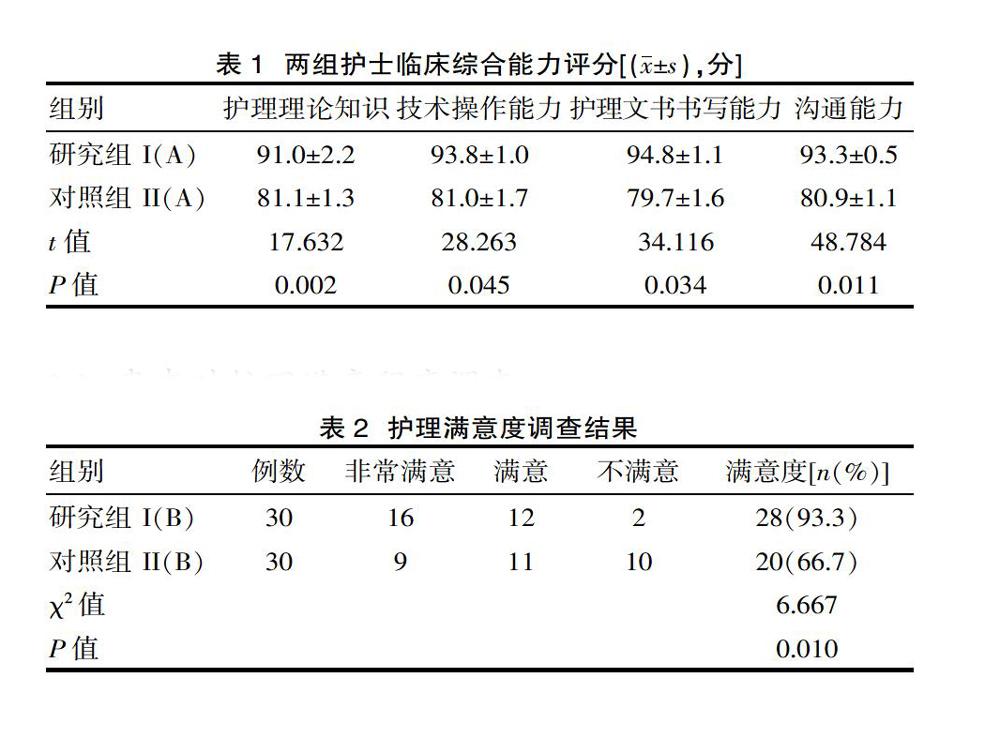护理管理工作中实施护士分层级管理模式对提升护理管理质量的价值研究
周仕莲

[摘要] 目的 分析实施护士分层级管理模式对提升护理管理质量是否具有明显的价值。方法 于2018年3—12月,随机选取护士40名并分为两组,研究组I(A)组与对照组II(A)组,每组各20名护士;同时,随机选取患者60例并分为两组,研究组I(B)组与对照组II(B)组,每组各30例患者。对II(A)及II(B)组给予常规的护理管理模式,同时,给予I(A)与I(B)分层级管理。在研究结束后,对I(A)及II(A)组的进行护理综合能力评分,在I(B)与II(B)组中调查患者对护理的满意程度。结果 对护理综合能力的评分显示, II(A)组显著低于I(A),而对护理满意程度的调查结果显示,II(B)组的满意度显著低于I(B)组。结论 在护理管理工作中施行分层次管理模式具有极高的价值,值得在临床中推广应用。
[关键词] 护理管理;分层管理;护理质量;价值分析研究
[中图分类号] R197 [文献标识码] A [文章编号] 1672-5654(2019)06(a)-0039-02
[Abstract] Objective To analyze whether the implementation of nurse hierarchical management model has obvious value in improving the quality of nursing management. Methods From March 2018 to December 2018, 40 nurses were randomly selected and divided into two groups, study group I (A) and control group II (A), with 20 nurses in each group. At the same time, 60 patients were randomly selected and divided into two groups, study group I (B) and control group II (B), with 30 patients in each group. Group II (A) and group II (B) were given routine nursing management mode, and I (A) and I (B) were given hierarchical management. At the end of the study, I (A) and II (A) groups were scored for comprehensive nursing ability, and patients' satisfaction with nursing was investigated in I (B) and II (B) groups. Results The score of comprehensive nursing ability showed that the satisfaction degree of group II (A) was significantly below than that of group I (A), and the survey result of nursing satisfaction degree showed that the satisfaction degree of group II (B) was significantly below than that of group I (B). Conclusion It is of great value to implement hierarchical management model in nursing management, and it is worth popularizing and applying in clinical practice.
[Key words] Nursing management; Stratified management; Nursing quality; Value analysis
隨着人们生活品质、经济、社会的不断进步,医疗行业受到了越来越多人的关注,包括护理质量,而对临床中的护理施以何种护理管理模式直接影响了临床中的护理质量[1-2]。分层级护理管理模式明确划分了护士职责,确保各层次护理人员分工明确,人尽其才,工作效率大大提升[3]。该文详细地研究了分层级护理管理模式在临床中应用的价值。报道如下。
1 资料与方法
1.1 一般资料
随机选取护理人员40名,并随机分为两组,分别为研究组I(A)组与对照组II(A)组。在I(A)组中,职称分别为:初级15名,中级5名;学历分别为:中专2名,大专13名,本科5名。在II(A)组中,职称分别为:初级13名,中级7名;学历分别为:中专4名,大专13名,本科3名。两组间的差异无统计学意义(P>0.05)。
同时,随机抽取患者60例,分为两组,研究组I(B)组与对照组II(B)组。在I(B)组中,男性患者18例,女性患者12例,平均年龄(40.7±2.7)岁。在II(B)组中,男性患者16例,女性患者14例,平均年龄(41.9±1.5)岁。两组间的差异无统计学意义(P>0.05)。
1.2 研究方法
对照组:以常规护理管理模式管理护理人员,且对患者给予常规的护理模式。
研究组:对护理人员给予分层级护理管理模式[4],即:①严格落实责任制度,界定管辖范围与职责,确保各自的工作质量。②强化护士的团队意识,协助其树立正确的人生观、价值观,团结合作。③实行奖惩制度,达到鼓舞目的,激发工作潜能,以达到提高护理质量。④改革排班模式,保证其休息充足,确保其身体基础条件良好。⑤实行“一带一”的模式,带动全体护士共同进步。

